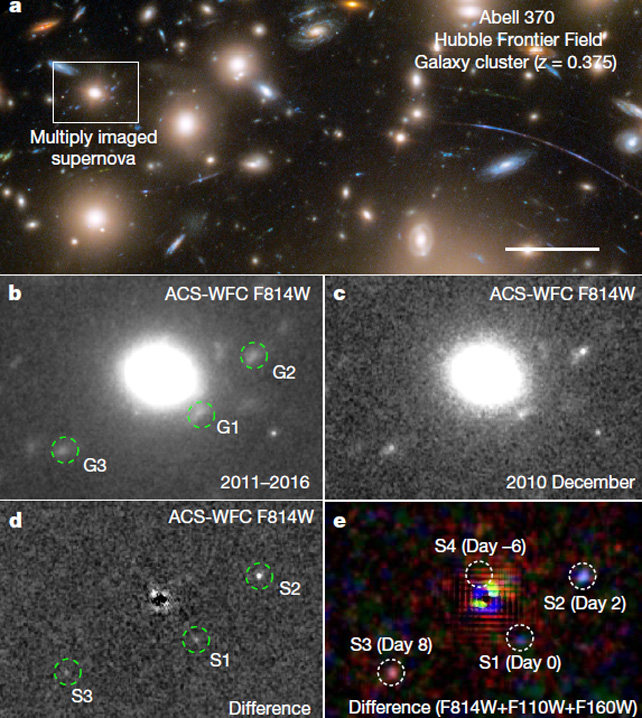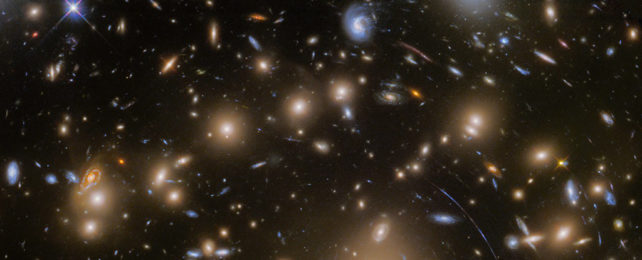It's an inconvenient truth of astronomy that nobody gets a personal invitation to witness a star's dying breaths. Catching sight of a star at a critical moment of its demise is a matter of fortune, making it a rare find.
With a bit of help from a conveniently-placed cluster of galaxies, an international team of researchers has measured the flash of light emitted by a distant supernova in three distinct moments.
The data will allow them to test theories about what the star's dying light could tell us about its size.
The star itself is far too distant for any telescope to make out in any detail. It's so distant that its light has taken around 11.5 billion years to cross the yawning expanse, arriving on our doorstep tangled amid the bright glow of countless other stars in its home galaxy.
However, we can observe the changes in the star's glow, and they reveal a few things about how it died. And lived.
Somewhere between here and there, the mess of starlight happened to pass within a section of the Abell 370 galaxy cluster – a knot of several hundred galaxies roughly 4 billion light years away.
Having so many galaxies close together is bound to put a big dimple into the cosmic landscape, causing the star's light to bend slightly as it slipped through.
The effect was somewhat like that of a giant, galaxy-sized telescope, one with a scratched and wrinkled lens warped by the uneven gravity.
Smeared into a configuration referred to as an Einstein cross, the original light was magnified and copied, producing subtly different versions of the distant galaxy as it appeared at different moments in time.
The researchers uncovered the ring of gravitationally lensed light in a survey of stars taken by the Hubble Space Telescope back in 2010. With some clever modeling, the team turned the light into something sensible, revealing three of the four points of the cross (the fourth was too faint to make out).

An analysis of the light within each smear revealed the swelling glow of an exploding star somewhere within, staggered across eight days. One featured the light just six hours after the initial burst.
Taken altogether, the three blurs of light provide details of the supernova slowly cooling over a week, from a blazing 100,000 degrees Kelvin to a much cooler 10,000 K.
Dying stars of a certain size don't go quietly into the night. Depleted of the atomic fuel to stoke their fires, they cool just enough for their cores to collapse with a fury that results in the mother of all nuclear explosions.
Knowing precisely when a given star will go bang is something researchers are slowly making process on. While the expanding shells of gas and light from supernova explosions aren't hard to find, catching a star in the moment of death takes a lot of luck.
Here, astronomers not only had the signature flash of a dying star in a galaxy far, far away, but they also had vital details on the changes in its light over a short period.
This information helps confirm models on how the material surrounding stars interacts with the burst of radiation from within, heating in a blink before quickly cooling again, allowing them to work backward to determine the star's original size from how it cools.
Based on what they learned in this case, the team is confident the star they witnessed in its dying moments had a radius more than 530 times that of our own Sun.
The study not only supports theoretical models on the evolution of supernovae and the stars that produce them, but it also opens the way to analyze a whole new population of stars from the early Universe.
And that's as close to an invite of a star's last fleeting moments as we'll ever get.
This research was published in Nature.
